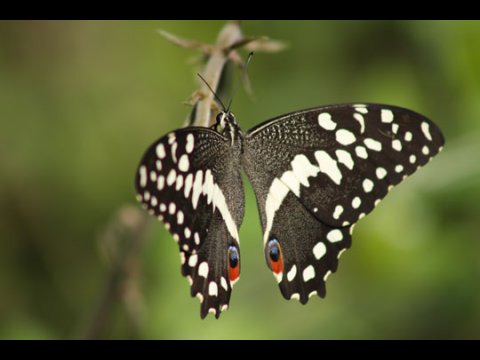
Graphium leonidas (Graphium leonidas)
Phylum — arthropoda
Class — insecta
Order — lepidoptera
Family — papilionidae
Genus – graphium
Appearance
The wingspan is 75–80 mm in males and 75–85 mm in females. The main color of the wings is black with pale green spots. There are large white spots at the base of the hindwings. There is the same pattern underside of the wing but on a brown background. The abdomen is black with small white spots. Males have a fold on the inner edge of each hindwing which encloses plumes of androconial scales. These specialized scales disseminate pheromones that are used to entice females into copulation.
Habitat
Graphium leonidas is found in all forested regions of sub-Saharan Africa.
Behavior
It demonstrates daily activity. The flight is fast and direct. Males are seen far more frequently than females, and are usually encountered as singletons or in two's or three's amidst aggregations of mud-puddling Pieridae. When not feeding they rest on the foliage of trees or bushes, with the wings held outspread.
Like other caterpillars of this family, the caterpillar of this butterfly has an osmetrium – a gland behind the head that extends in danger and looks like two long orange-red "horns".
Graphium leonidas has continuous broods, peaking from October to April.
Diet
The larvae feed on Annona, Monanthotaxis, Uvaria (Annonaceae) and Landolphia (Apocynaceae).
Reproduction
For their reproduction you need a terrarium with a size of 50 x 50 x 70 cm. Females lay eggs one at a time on the leaves of the forage plant. It is better to keep the caterpillars in containers with a mesh lid of 6-8 pieces. In the container, you need to place a forage plant. The temperature is 23-25 oC at the humidity of 65-75 %. The pupa is light green with vertical ochreous stripes. It has a horn on the head. The duration of the butterfly's development cycle is about a month.
In captivity
The mesh terrarium with a size of 50 × 50 × 70 mm is suitable for keeping butterflies. Room temperature is necessary. Daylight time is 12 hours. You can feed the butterflies with honey syrup diluted with boiled water in a ratio of 1: 10.
 Russian
Russian
 English
English


















